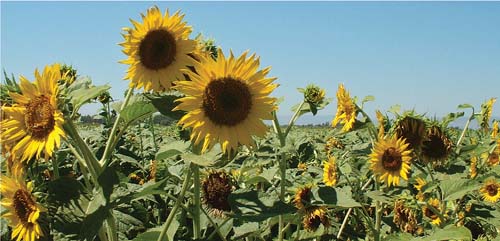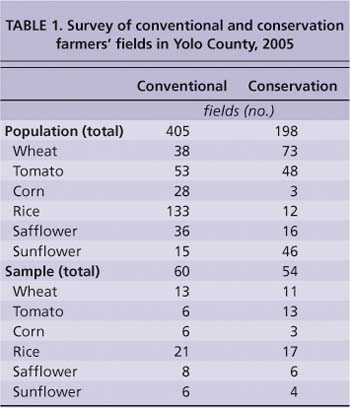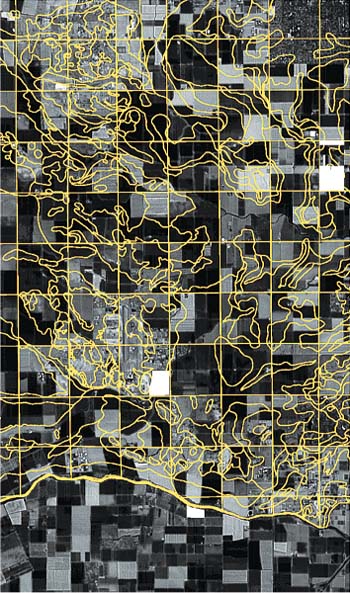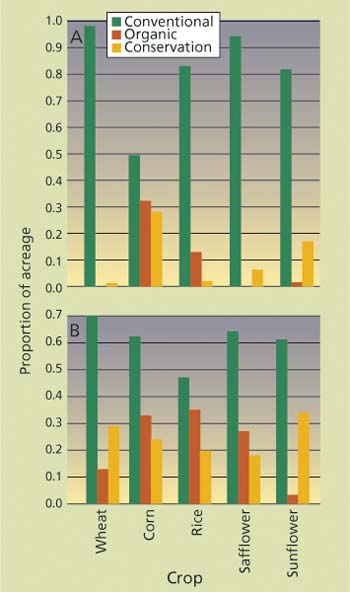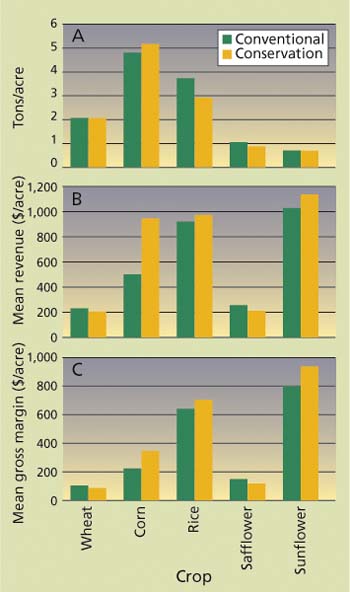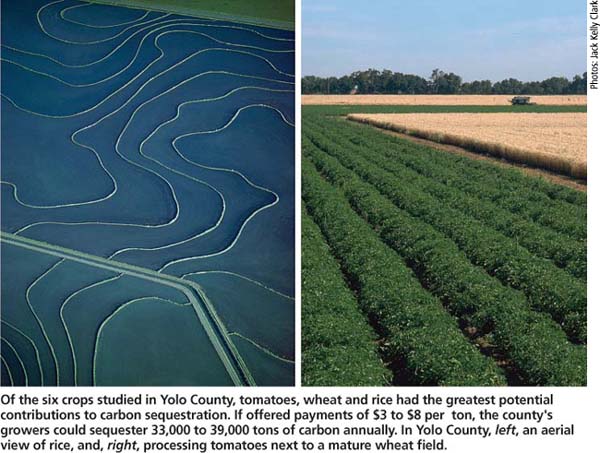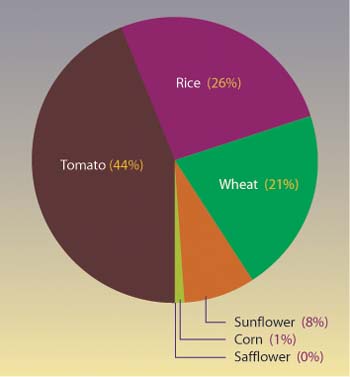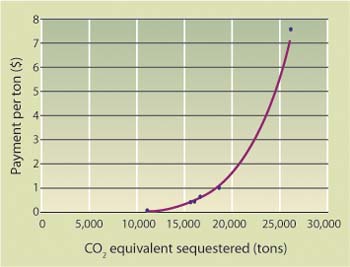All Issues
Realistic payments could encourage farmers to adopt practices that sequester carbon
Publication Information
California Agriculture 63(2):91-95. https://doi.org/10.3733/ca.v063n02p91
Published April 01, 2009
PDF | Citation | Permissions
Abstract
Carbon sequestration in agricultural land has been studied over the past few years to determine its potential for ameliorating climate change, Agricultural soils can be efficiently exploited as carbon sinks with a variety of techniques, such as reduced tillage, cover cropping and organic systems with better manure management. However, to fully understand the potential of carbon sequestration in agriculture, the economic costs of switching from conventional to conservation management must be estimated. Since carbon sequestration depends heavily on management, crop and soil type, we conducted a field-level survey of its economic aspects in Yolo County for the 2005 growing season. The survey showed that organic and conservation management can be more profitable for field crops than conventional management in Yolo County. Finall, we demonstrated how to combine the survey data with an agronomic process model to predict the rate of adoption for conservation techniques in response to carbon payments.
Full text
The Conservation Security Act — title II of the 2002 Farm Bill — authorized the U.S. Department of Agriculture to make payments to armers who adopt environmental practices such as conservation tillage, cover crops and manure application (USDA 2002). This was a significant shift from prior conservation policies, which provided incentives to retire agricultural land. The revised Conservation Security Act switched the focus to maintaining lands in agricultural production while encouraging
Actual management and economic information for alternative agricultural practices in Yolo County was used to develop a model for predicting grower reactions to carbon contracts. Above, a no-till air drill is used to plant wheat into safflower stubble.
California has the potential to sequester additional amounts of carbon in its forests, agricultural soils and geological formations. The agricultural sector can realize its potential for carbon sequestration by adopting new forms of management. De Gryze et al. (2009) (see page 84) addresses questions of whether changes in management affect yields, and the total biophysical potential for greenhouse-gas mitigation. We ask what financial incentives farmers would require to change their management such that carbon sequestration increases in Yolo County.
This question is particularly relevant since agricultural carbon sequestration is at the center of a debate. Skeptics argue that there are uncertainties about the amount of carbon that can be effectively sequestered due to complex interactions between agronomics and economics. Proponents argue that besides reducing greenhouse gases, carbon sequestration presents an opportunity to make more sustainable farming methods profitable to farmers, since practices that sequester carbon also reduce drain-water pollution, dust and other air pollution.
Carbon sequestration in agriculture depends on microclimates, soil types, management practices and crop choices. The fundamental result of these practices is to increase the organic matter sequestered in the soil. All of these factors vary over agricultural regions, and region-specific research is needed to make policy decisions about the effectiveness of carbon sequestration. We first present results of a survey of all farmers practicing conservation management in Yolo County in 2005, then combine our results with those from De Gryze et al. (2009) to derive a carbon-sequestration supply curve for the county.
Carbon-sequestration economics
Most studies of the economics (and agronomics) of sequestration have focused on Midwestern agriculture, with little empirical research in California. There are several reasons for this. First, the rotations in Midwestern agriculture are typically simpler to simulate and predict than those in the more complex Californian crop agriculture. Most available empirical studies (McCarl et al. 2007; Mooney et al. 2004) are based on typical Midwestern row-crop systems such as corn-soy-feed crop rotations, where the typical feed crops include silage corn and sorghum, and Great Plains dryland grain systems (crop-fallow rotations). In order to make the analysis feasible, empirical examples are often restricted to regions where wheat is a prominent crop and a simple wheat-fallow rotation is used. This greatly simplifies the subsequent economic analyses, since the research can focus exclusively on the farmer's management decision in response to a carbon contract without the complication of crop changes.
For California agriculture, however, the diversity of high-valued crops makes it difficult to reduce the observed field cropping patterns to stylized rotations such as those found in the Midwest or Great Plains (Metherell et al. 1995; Parton et al. 1987). California farmers face a chain of crop decisions. The agronomic and economic factors that shape future rotations depend on factors such as the farmer's beliefs about future crop and input prices, land suitability and weather conditions.
In this context, it is likely that a change in management would be accompanied by an adjustment in crop choices. Therefore, management changes induced by carbon contracts are likly to change not only how a crop is grown, but also the proportional areas of crop types on a farm. To measure the potential carbon-sequestration respnse, an analysis must be able to predict the effect on expected future farm profits of both the changes in management and the consequent changes in crop proportions.
Yolo County farmer survey
Predicting farmer reactions to carbon contracts requires information on field-level costs and management practice, while controlling for soil and weather factors. Current sources of information about cultivation practices are insufficient. The cost and return studies carried out by the UC Davis Department of Agricultural and Resource Economics (Klonsky 2007) are an extremely useful resource for establishing guidelines to help the farming community make management decisions. However, the studies are based on assumptions describing typical farm operations, and the level of aggregation does not allow the interaction of costs and management with the given soil characteristics of a plot.
At the other extreme, budgetary information from UC Davis experimental sites (Mitchell et al. 2005) provides an essential input to assess the effects of conventional and alternative farming systems on the environment and sustainability, but the sites are managed under experimental rather than profit-maximizing criteria. Our survey aims to fill the gap between these two sets of information by recovering actual management and economic information on alternative practices at the field level.
Farmer and crop selection.
In 2005, we identified those farmers in Yolo County who were already undertaking conservation management — such as conservation tillage, cover crops and manure application — and the specific soil type on which it was applied. First, we had to narrow down the number of crops to make modeling feasible. Because of the diversity of crops a farmer can choose to plant on a given piece of land, we focused on those field crops most likely to be incorporated in a standard Yolo County rotation. After talking directly to farmers and consulting historical records, we decided to interview those farmers who grew the six most common crops suitable for alternative management: tomato, wheat; corn, rice, safflower and sunflower (CDFA 2006; CTIC 2002). We used the Pesticide Use Reports for Yolo County (CDPR 2008) to identify farmers who planted these crops under conventional or reduced (or conservation) tillage and had managed the same field for the last 4 years. We used the California Certified Organic Farmers registry (CCOF 2008) to identify organic growers of the six crops. These data sources were also used to construct a sample frame listing all relevant farmers, from which the sample selected at random. This method prevents selection bias in the sample. In 2005, 224 farmers were using conventional methods and 41 were using conservation methods to grow the six selected crops in Yolo County.
Based on computer modeling of Yolo County agriculture in 2005, the authors predict that growers could switch to more environmentally friendly practices if offered reasonable carbon-sequestration payments. Above, sunflower, one of the crops studied.
Fields and soil type.
Finally, since our intention was to survey at the field level, we obtained maps from satellite images and allowed the farmers to randomly choose the field for the designated
Fig. 1. Field image and soil type by town, range and section grid for Yolo County, 2005. White rectangles represent surveyed plots; irregular curves show soil-type delineations.
Conventional vs. conservation
Crops.
A problem in obtaining a large number of observations for conventionally managed fields is that some farmers diversify by producing several of the six selected crops (table 1), but it is unreasonable to expect them to respond to more than one questionnaire. We surveyed the entire population of Yolo County growers identified as using conservation management, and obtained data on their total 2005 acreage and number of fields. Since our study is the first comprehensive survey of conservation management in California, we decided to include all the organic farmers who had grown any of the six crops during 2005. The census approach at the farmer level allowed us to identify the total number of fields under this management category.
Combined management.
In Yolo County, some farmers using predominantly conventional management also grew corn and rice under organic or conservation-tillage systems (fig. 2A). Likewise, many registered organic growers and others using conservation tillage also had significant proportions of their farm under conventional crop management (fig. 2B). It appears that organic and conservation management are making inroads into conventional farm systems, while many organic growers also use conventional methods for key field crops. For example among the conservation growers, 70% of the wheat and 62% of the corn was grown with conventional methods.
Yields and returns compared.
Compared to conventional management, we found that yields under conservation management were lower for rice and safflower, higher for corn, and the same for wheat and sunflower. Tomatoes were not included in the yields, due to poor wording on the survey form that did not accurately distinguish between processing and vine tomatoes (fig. 3A). On average the survey results did not show conservation managers paying a yield-loss premium. When the yields were combined with some representative organic price premiums, revenues were higher under conservation management for three of the five field crops (corn, rice and sunflower) (fig. 3B). Only wheat and safflower revenues were reported as slightly lower under conservation management.
Fig. 3. Mean (A) yields, (B) revenues and (C) gross margins for crops grown under predominantly conventional or conservation management in Yolo County, 2005.
With the exception of corn, the gross margins calculated from the survey responses had a similar pattern, showing that differences in the variable costs of production, notably in cultivation and machinery costs, were not very significant (fig. 3C). These gross margins showed that compared to conventional farming, applying conservation practices in production resulted in higher returns per acre over variable costs on average in 2005. However, this higher average value hides the fact that, from our observations, the profits among organic growers were much more volatile than those among conventional growers.
Modeling carbon sequestration
The survey was designed to be coupled with DAYCENT, an agronomic process model (Del Grosso et al. 2008; see also De Gryze et al. 2009, page 84). The DAYCENT model was tailored to encompass both county and field-level soil types and management alternatives. From this we computed the change in carbon-sequestration potential for alternative practices on each field, based on management and crop history. Combining the DAYCENT and economic models allowed us to perform a sequestration analysis that previously was possible only with experimental data. From the survey, we used farmers' actual data on management and costs to derive a county-level carbon-sequestration supply curve (function), which shows the way that a farmer's carbon sequestration responds to carbon payments.
We modeled the 405 fields from conventional farmers using land-use data provided by Pesticide Use Reports. We then used estimates for average total variable costs, and constructed estimates of profits for each field by multiplying the price per yield obtained by the DAYCENT plant-growth model for crops grown in 2005 under alternative management systems.
Of the six crops studied in Yolo County, tomatoes, wheat and rice had the greatest potential contributions to carbon sequestration. If offered payments of $3 to $8 per ton, the county's growers could sequester 33,000 to 39,000 tons of carbon annually. In Yolo County, left, an aerial view of rice, and, right, processing tomatoes next to a mature wheat field.
We modeled five alternative management practices: (1) conservation tillage, (2) conservation tillage with organic fertilizer, (3) conventional tillage with organic fertilizer, (4) conventional tillage and cover crops with organic fertilizer and (5) conventional tillage and cover crops.
Fig. 4. Predicted allocation of total tons carbon dioxide equivalent among crops under reduced tillage in Yolo County, 2005.
How farmers make decisions
Analyzing the survey data, we confirmed that a pure conservation-tillage system must be treated differently from organic systems. Organic growers reported significantly higher production costs of labor, cultivation and weed control than conventional farmers. In contrast, adopters of conservation tillage reported lower production costs due to lower fuel expenses and labor hours for ground preparation.
Modeling the simultaneous questions of how farmers choose what crop to grow and how to grow it requires a complicated statistical approach (Català-Luque 2007). Essentially, the probability that a farmer will find it attractive to make changes in both production methods and cropping pattern must be estimated jointly, but then teased apart to measure their relative contributions to farm profits.
Combining the survey information with the DAYCENT model resulted in a response curve for carbon sequestration based on the adoption of alternative practices. The response curve for Yolo County relates the increase in the total amount of carbon sequestered by conservation tillage adoption to the level of payments per ton of carbon dioxide equivalent (CO2e) per year. The model results indicated that on the whole, field productivity drives farmer decisions. Productivity is based on current and past weather and water availability, and reflects the multiple factors used by farmers to make decisions on how and what crop to grow in a particular field.
In contrast, while reported operation costs based on the survey results varied by crop and management, these seemed much less important in making the final decision of what to grow and how to grow it. This result is reasonable since it indicates that a farmer, knowing the properties of his land, is going to make use of it in the best way. Operation costs will likely have much more influence at the farm scale than at the field scale. This focus on crop productivity will help implement carbon-sequestration payments, since it makes their success dependent on well-known biophysical conditions such as soil type.
Alternative management costs
Having used the detailed field data to project our results at the county level, we summed each crop's carbon-sequestration supply for a particular alternative management. This operation calculated the amount of carbon that can be sequestered or avoided by adopting a specific management practice in Yolo County, and the associated cost of this abatement. The cost of abatement, or “price” of carbon sequestration, is the break-even cost of adopting a management practice for a given crop rotation compared with using conventional practices. Because they were statistically computed from the survey, these costs do not includes farmers' preferences or perceptions of risks, and thus we should interpret the results as an abatement cost curve that reflects the direct costs of management changes. If risk factors were included, we would expect a steeper abatement cost curve.
The potential for sequestration was calculated for each of the five management approaches. For reasons of space, we only present the carbon sequestration supply curve from the most promising alternative, conservation-tillage. While conservation tillage does not have the greatest physical potential for sequestration, it is probably the most promising from a joint agronomic and economic implement payments for reduced tillage in a simpler and cheaper manner.
The proportional sequestration contribution by crop showed that under conservation-tillage practices, tomatoes were the highest contributor to greenhouse-gas reduction (fig. 4). Tomatoes are the most important crop in Yolo County, and the agronomic processes involved in tomato cultivation lend themselves to conservation tillage. Wheat, rice and sunflower contributed 55% of the sequestration, and corn and safflower made small contributions to the total carbon sequestration.
Implementing carbon payments
The DAYCENT model enabled us to link a quantity of carbon sequestered to the crop and acreage, enabling the generation of a carbon-sequestration supply curve that shows the relationship between carbon payments and tons of carbon sequestered by agriculture in Yolo County (fig. 5). As a result, we can draw some conclusions about the implementation of a carbon payment system for crop agriculture.
First, the combination of economic and biophysical models enabled us to develop regional carbon-sequestration supply curves for agriculture. Second, we predict that farmers could change their crop technologies in response to reasonable carbon-sequestration payments. Third, the cost of carbon-sequestration changes with soil and crop type. We do not explore the implementation costs for carbon contracts in this paper; see Mooney et al. (2004).
The carbon-sequestration supply curve shows that by adopting conservation-tillage practices in response to carbon payments of $3 to $8 per ton per year, Yolo County could sequester as much as 33,000 to 39,000 tons of carbon, approximately 3% of the county's total carbon release. Given that current carbon payments on the Chicago Climate Exchange vary around $7 per ton, this is a realistic policy. If U.S. carbon emissions were capped in the future, carbon prices would increase and additional alternative-management practices and greater sequestration would occur.
It should be noted that the shape of the carbon-sequestration supply curve indicates that relatively low carbon payments can induce the adoption of sequestering technologies by farmers. While the carbon reduction from this single sequestration policy is small, many other beneficial ecosystem services are associated with alternative management methods. For example, conservation tillage reduces water run-off, the generation of dust particles and associated pollution. Plans are under way to extend the Yolo County model to other counties. Since the adoption model is largely driven by biophysical factors, a carbon-sequestration supply curve can be developed for different areas using the existing regional field data on cropping patterns, microclimates and soil types.




